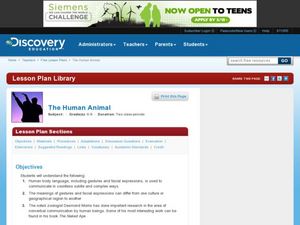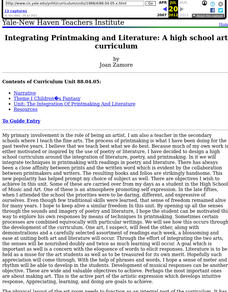Curated OER
Confronting Genocide
Students discover what the term genocide means and are assigned to groups to reasearch an act of genocide in order to answer each question from their worksheet. They then compare their results making special notes of patterns they observe.
Curated OER
The Human Animal
Students explore non-verbal communication. In this animal communication lesson, students study body language and other forms of non-verbal communication. Students write a summary of their findings to discuss with the class. This lesson...
Curated OER
Patterns
Students identify patterns in equations. In this algebra lesson, students write equations of problems with recurring patterns. They relate and model real life situation using functions.
Curated OER
"Live Out Loud" Celebrates Pride Week
Students investigate human relationships by creating oil paintings in class. In this gay pride lesson, students discuss why the Pride parade is so important, who appears at the parade and how art is used to spread awareness of gay...
Curated OER
Integrating Printmaking and Literature: A high school art curriculum
Students integrate techniques in printmaking with readings in poetry and literature. They read various pieces of student literature and poetry, and create prints using various printmaking techniques.
Curated OER
Taxation Without Representation
Eighth graders empathize with how colonists felt when they were taxed without representation. They use a metaphor of students and a school principal to describe the strained relationship that developed between the colonies and Britain.
Curated OER
Handling Emergencies and Placing Emergency Calls
Learners create posters detailing how to activate 911. They design posters and research websites for local police department information and 911 calling advice. They write directions for placing emergency calls and crete their posters...
Curated OER
Figurative Language: Metaphors and Similes
Fifth graders are introduced to the figurative language using metaphors and similies. They identify the similarities and differences between the two and practice developing their own to use in their writing. They illustrate their...
Curated OER
Dichotomous Key for Identifying Pine Trees
Pupils identify the species of pine trees that are found in their area. They use unlabeled "mystery" samples and a dichotomous key to identify the pine trees to species. After identification, they use a field guide to answer worksheet...
Curated OER
Shoes: Practical vs. Fashionable
Learners compare and contrast the difference between practical applications of apparel and the use of fashion as a status symbol, with a focus on shoes. Working in groups, they complete a Venn diagram comparing practical fashion to...
Curated OER
Circle of Friends
Students investigate the meaning of friendship and how to make friends. In this friendship lesson, students make Venn Diagrams showing the similarities and differences of characters in two stories. They discuss their own circle of friends.
Curated OER
Martine Luther King Jr. and John Lewis: Speeches at the March on Washington, August 1963
Ninth graders study the Civil Rights Movement. In this American History lesson, 9th graders analyze the speeches of major civil rights leaders. Students compare and contrast the meanings of these speeches.
Curated OER
Classify Machines that Fly!
Eighth graders explore flight and the dichotomous key. In this flight lesson, 8th graders gain understanding of the dichotomous key and create one of their own. Students then use their dichotomous key to classify types of aircraft.
Curated OER
Developing Students' Vocabulary Range for Describing People
Middle schoolers develop vocabulary for describing people.
Curated OER
Boy Cricket Girl Cricket
Students investigate crickets. In this series of cricket activities, students observe and chart crickets. Students discuss the differences between male and female crickets, record findings in a journal, handle crickets, and read a...
Curated OER
Reading Comprehension
First graders listen and read along as a story is read to them. They discuss what they read when finished with the text. Students discuss the story vocabulary and the word meanings. They practice decoding unknown words and complete a...
Curated OER
Using Authentic Texts to Teach Vocabulary
Students read an article identifying any new vocabulary words they are unfamiliar with. Using the text, they discover antonyms, synonyms and word families. They answer comprehension questions and review the vocabulary to end the lesson.
Curated OER
I Can Read Fast, Smooth, and Expressively!
Students listen to the explanation of the words expressively, smoothly, and quickly as being keys to fluent reading. They review some of the vowel sounds and identify them in different words and listen to some passages from The Rainbow...
Curated OER
Synonyms: Say It Again!
Students discuss and learn synonyms. In this synonyms instructional activity, students use a thesaurus to look up synonyms for the given list of words.
Curated OER
Homophones dictation
Learners notice their problems with a particular listening activity or even with spelling a word wrongly. They write 8 to 10 homophones and check what they have written down. They say the spelling and also the meaning and discover the...
Curated OER
Poetic Devices
In this figurative language worksheet, students read and study examples of simile and metaphor. There are 20 questions to be used with Smartboard and 10 questions in which students identify similes or metaphors.
Curated OER
Wolf Habitat
Students identify their own basic needs for food, water, shelter and space in a suitable arrangement. They generalize that wolves and people have similar basic needs.
Curated OER
Sing, America, Sing!
Students articulate their thoughts about citizenship in songs and poems. They write a songor a poem that describes what citizenship means to them. They plan a Citizenship Day during which students perform their songs and read their poems.
Curated OER
Communities
Students examine the similarities and differences between rural, suburban, and urban communities. They read about type of community in their social studies textbook, analyze the differences between Tokyo and Chicago, and complete a chart...

























